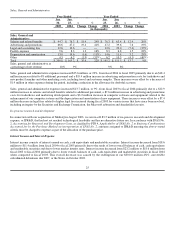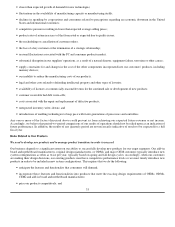NVIDIA 2005 Annual Report Download - page 40
Download and view the complete annual report
Please find page 40 of the 2005 NVIDIA annual report below. You can navigate through the pages in the report by either clicking on the pages listed below, or by using the keyword search tool below to find specific information within the annual report.
• introduce the products to the market within the limited window for OEMs, ODMs and add−in board and motherboard
manufacturers.
If ODMs and OEMs do not include our products in their systems, they will typically not use our products in their design systems until
at least the next design configuration. Therefore, we endeavor to develop close relationships with our OEMs and ODMs in an attempt
to allow us to better anticipate and address customer needs in new products.
As a result, we believe that significant expenditures for research and development will continue to be required in the future. We make
these expenditures independent of the level of purchase commitments from our customers. If our new products are not adopted by our
customers, our business results may be adversely affected. The success of new product introductions will depend on many factors,
including the following:
• proper new product definition;
• timely completion and introduction of new product designs;
• the ability of IBM, TSMC, UMC, Chartered and any additional third−party manufacturers to effectively manufacture our new
products in a timely manner;
• dependence on third−party subcontractors for assembly, testing and packaging of our products and in meeting product delivery
schedules and maintaining product quality;
• the quality of any new products;
• differentiation of new products from those of our competitors;
• market acceptance of our products and our customers' products; and
• availability of adequate quantity and configurations of various types of memory products.
A critical component of our product development effort is our partnerships with leaders in the computer aided design, or CAD,
industry. We have invested significant resources to develop relationships with industry leaders, including Cadence Design Systems,
Inc. and Synopsys, Inc., often assisting these companies in the product definition of their new products. We believe that forming these
relationships and utilizing next−generation development tools to design, simulate and verify our products will help us remain at the
forefront of the 3D graphics, communications and networking markets and develop products that utilize leading−edge technology on a
rapid basis. We believe this approach assists us in meeting the new design schedules of PC OEMs and cellular phone manufacturers. If
these relationships are not successful, we may not be able to develop new products in a timely manner, which could result in a loss of
market share, a decrease in revenue and a negative impact on our operating results.
In addition, our strategy includes utilizing the most advanced semiconductor process technology appropriate for our products and
available from commercial third−party foundries. Use of advanced processes has in the past resulted in initial yield problems. New
products that we introduce may not incorporate the features and functionality demanded by OEMs, ODMs, add−in board and
motherboard manufacturers and consumers of PCs and consumer electronics. Even if we are able to provide the demanded features
and functionality, we may not be able to successfully develop or introduce new products in sufficient volumes within the appropriate
time to meet both the OEMs' design cycles and market demand. We have in the past experienced delays in the development of some
new products. Our failure to successfully develop, introduce or achieve market acceptance for new digital media processors would
harm our business. In particular, during the first half of fiscal 2004, we experienced delays in the introduction of digital media
processors using our next generation technology. In addition, we expected to ramp up sales of our PCI Express products during the
second quarter of fiscal 2005, but as a result of Intel's delayed PCI Express chipset production, followed by their product recall, the
performance desktop segment was impacted by stalling our customers' production ramp of our GeForce PCX GPUs. Any such delay
in the future or failure of our digital media processors or other processors to meet or exceed specifications of competitive products
could materially harm our business.
34
























